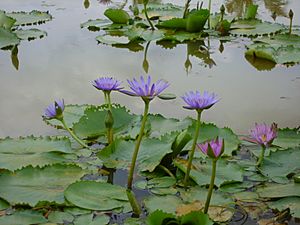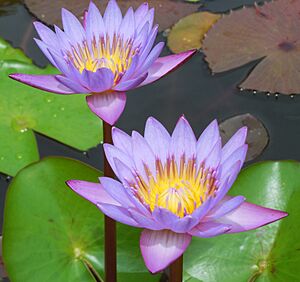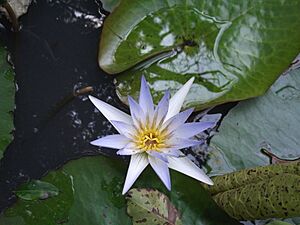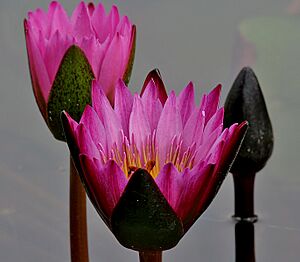Nymphaea nouchali facts for kids
The Blue Star Water Lily (scientific name: Nymphaea nouchali) is a beautiful flowering plant that lives in water. It is part of the water-lily family, called Nymphaeaceae. You can find this plant naturally in southern and eastern Asia. It is also known by other names like red and blue water-lily or star lotus.
Contents
About the Blue Star Water Lily
This water lily grows from special underground stems called rhizomes or tubers. These parts are like thick roots that stay hidden under the water. The leaves of the plant are oval or round. They can be about 13–15 cm (5–6 inches) wide. The leaves float on the water's surface.
Flowers and Appearance
The flowers of the Blue Star Water Lily are shaped like stars. They usually have 4 sepals and 10–16 petals. Each flower can be 5–13 cm (2–5 inches) across. While the leaves float, the flowers often stand about 30 cm (12 inches) above the water.
Most of the time, the flowers are a pale blue color. But you can also find them in pink or white. They have pale yellow parts inside called stamens and anthers. These flowers do not have a strong smell.
Uses of the Water Lily
People in southeast Asia have grown Nymphaea nouchali for hundreds of years. It is often found near temples. In Sri Lanka and parts of India, people also grow it. They even collect it from dried-up ponds.
Food and Medicine
The rhizomes of this plant are used as food. They are a good source of starch. Sometimes, they are also fed to animals. In Ayurvedic medicine, which is a traditional Indian healing system, this water lily is used to help with indigestion.
Different Types of Water Lilies
There are different types, or "cultivars," of Nymphaea nouchali. One type, called N. stellata var. cyanea, has blue flowers that can be light or dark. Another type, N. stellata var. versicolor, is often sent from Sri Lanka to places like Europe and the U.S.
These tubers are popular for aquariums. They grow very quickly when placed in warm water. This makes them a fast way to add plants to a fish tank.
Symbolism
The Blue Star Water Lily holds special meaning in some places. A pale blue version of N. stellata is the National flower of Sri Lanka. In Sri Lanka, it is known as nil mānel or nil mahanel. This beautiful flower was also the state flower of Hyderabad Deccan in the past.
See also
 In Spanish: Nenúfar de Sri Lanka para niños
In Spanish: Nenúfar de Sri Lanka para niños





